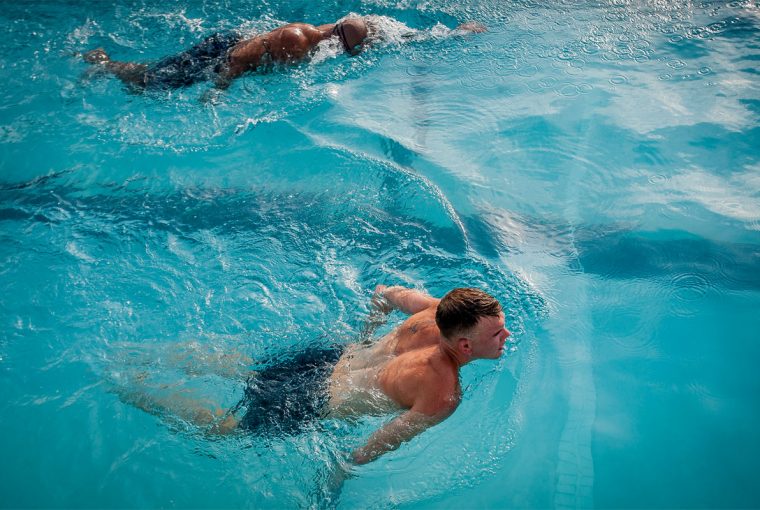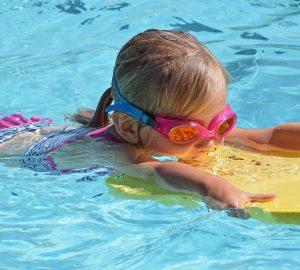If there’s any experience that typifies the summer months on the East Coast, it’s grimly enduring a brand of humidity that compares only to the depths of a soggy hell. Some days, the sweat pouring from parts of the body that you forgot were capable of sweating—GAH, the forearms!—may compel you to reevaluate your best-laid exercise plans. On a humid, 90-degree afternoon, the very idea of running sounds horrifying, unless it occurs in a straight line to the ice cream truck.
You know what you might like, though? You might like swimming in a cool, refreshing, rejuvenating pool.
This is a good thing. Because swimming—when done in an athletic capacity, not in the I’m-gonna-float-here-and-drink-a-beer capacity—is a fantastic cardio workout that is easy on the joints and can allow you to burn more than 700 calories an hour. If you want to suit up for fitness’ sake but aren’t sure where to start, we’ve got the expert-backed tips you need to dive right on in. (Please make sure you’re not in the shallow end first.)
1. It’s normal to feel like you’re out of shape
Swimming is a really, really technical sport. From breathing to stroke mechanics, there are a lot of factors that go in to whether one can make it down the lane and back once—never mind over and over again.
“It is common for guys who are runners and cyclists in good shape to feel discouraged when they get into swim training,” says Lance Watson, an Olympic gold medal triathlete coach and inductee into the Ironman Hall of Fame. “It can be demoralizing to feel like you’re doing a hill sprint halfway across the pool. You are not alone.”
2. You’re going to need to be cool with a swim cap
This is non-negotiable. You may not think you look as natural in the head condom as, say, Michael Phelps, but most pools require everyone who gets in to cover up. Caps protect your hair (or scalp—bald brethren are not exempt) from the damaging effects of chlorine, keep loose strands out of the water, and help to reduce drag. Many pros wear two at a time to address these various concerns: Cap one keeps everything together, while cap two goes over the goggles and smoothes out the ride.
3. Take a deep breath
When you train for land sports, there isn’t much thought that goes into the rhythm of breathing—as you push harder, your pace of breathing increases instinctively. But for swimming workouts? It’s something to which you have to dedicate some effort.
“Most beginning swimmers intuitively hold their breath when their face is in the water, and then quickly attempt a full exhale and inhale when turning to the side,” says Watson. “This quickly creates a build-up of CO2 in the lungs and bloodstream.” Novices end up desperately gasping for air, flailing about in the water like James Harden looking for a whistle on the drive.
To get comfortable, practice the sequence outside of the pool (and maybe out of clear view of other people who may become concerned for your well-being). While executing a mock freestyle stroke with your arms, focus on inhaling between strokes, with your face to the side, and exhaling with your face—which would be in the water, of course—down.
When you feel confident with the whole head-turning sitch, try a damp version. Immediately after taking a breath, slowly exhale through your nose and mouth. Then, when you turn to breathe, you will have gradually emptied your lungs and are ready to inhale again. Just as there is a rhythm to your cadence with running or cycling, strive to create a rhythm with your breathing: every three strokes or so during light to moderate swimming, and every other stroke for high-effort swims.
4. Swim toys: Not just for kids
Forget the arm floaties and inner tubes from summer camp. Experimenting with tools like pull buoys, paddles, kickboards, fins, and snorkels can be really beneficial for your overall performance. “They’re a great way to mix things up,” says triathlete and American Ironman record holder Linsey Corbin. She suggests using them for area-specific training—holding onto the kickboard while using only your legs to get across the pool, for example.
5. If you’re just swimming laps on laps, you’re doing it wrong
Swimming for fitness is more than vanilla down-and-backs. Use “sets,” which are essentially interval training programs for the water, to divide the workout into segments. Watson suggests doing a 5×100, 4×100, 3×100, 2×100, and a final 100. This means five uninterrupted 100-meter swims—that distance is usually one lap, but check the length of your pool to confirm—followed by a break. Continue down the ladder until you’ve finished.
Things get complicated when you add other special words to the mix. Make Watson’s workout “descending,” for example, by aiming to swim each section faster than the one before—start at a deliberate pace into your 5×100 and build to a sprint for the single 100-meter dash. For “ascending” work, start at top speed, and then slow down with each segment.
6. Consistency is key
It’s normal if your swimming workouts doesn’t feel as effortless as the Olympians make it look on TV. Remember: It took them a long, long time to achieve that level of Beyoncé-esque flawlessness.
“Like the line from Finding Nemo: Just keep swimming,” says Corbin. “The more you swim, the better you will get. Have fun with it, stick to a routine, and try to apply some consistency to your swim training to see some real gains.” And when “gains” include things like toned triceps, a leaner midsection, lower blood pressure, and even a lowered mortality risk? That’s well worth getting over how goofy you look in a swim cap.




